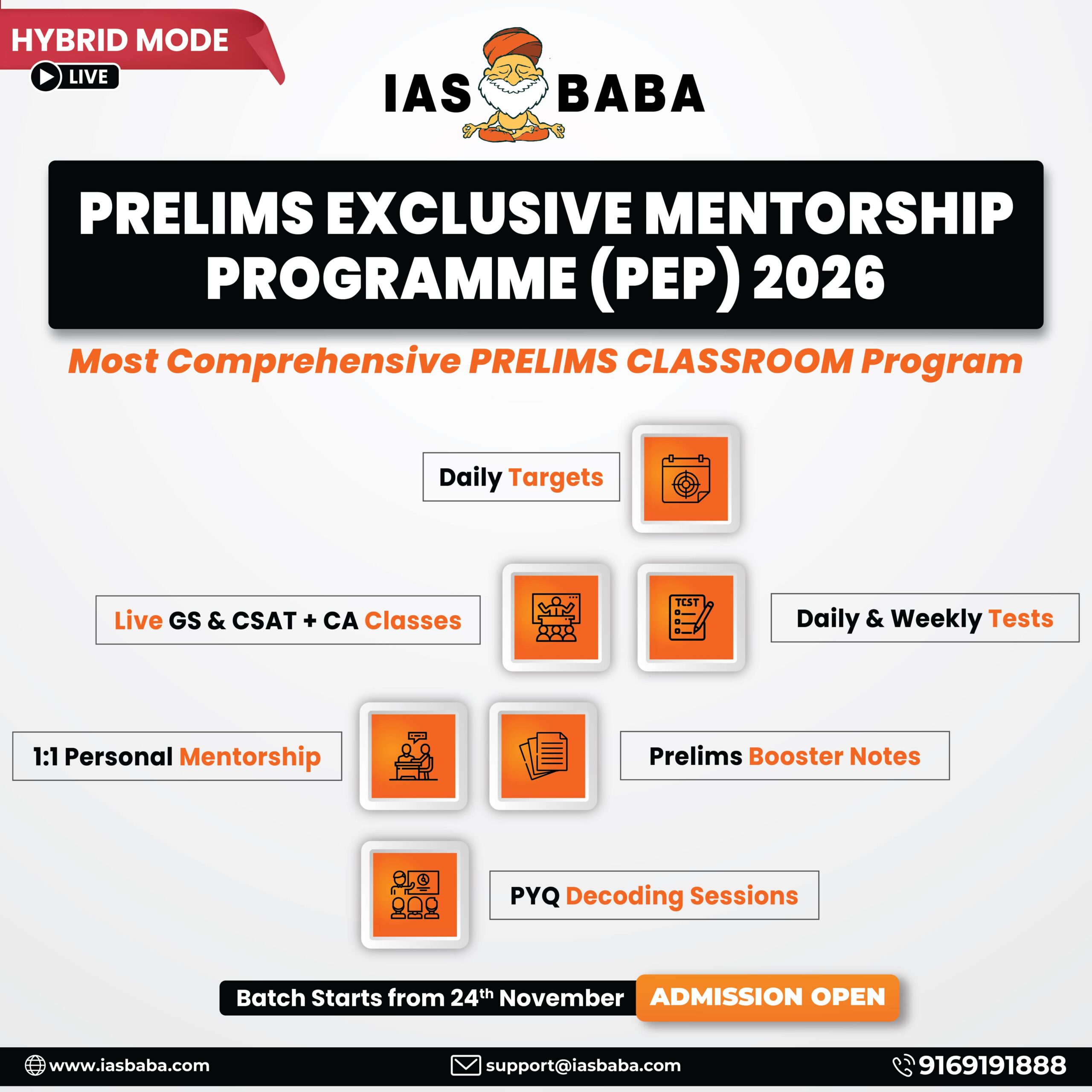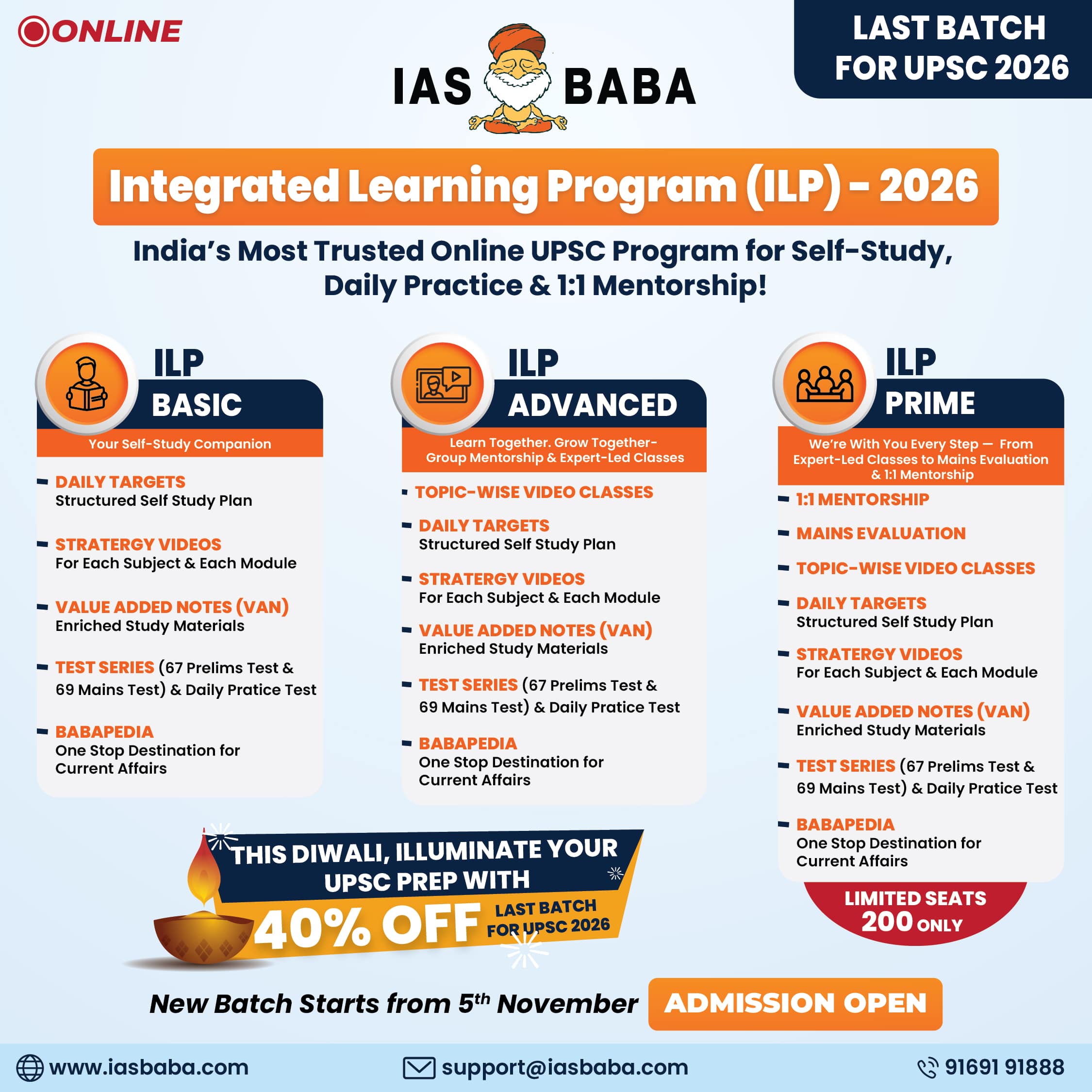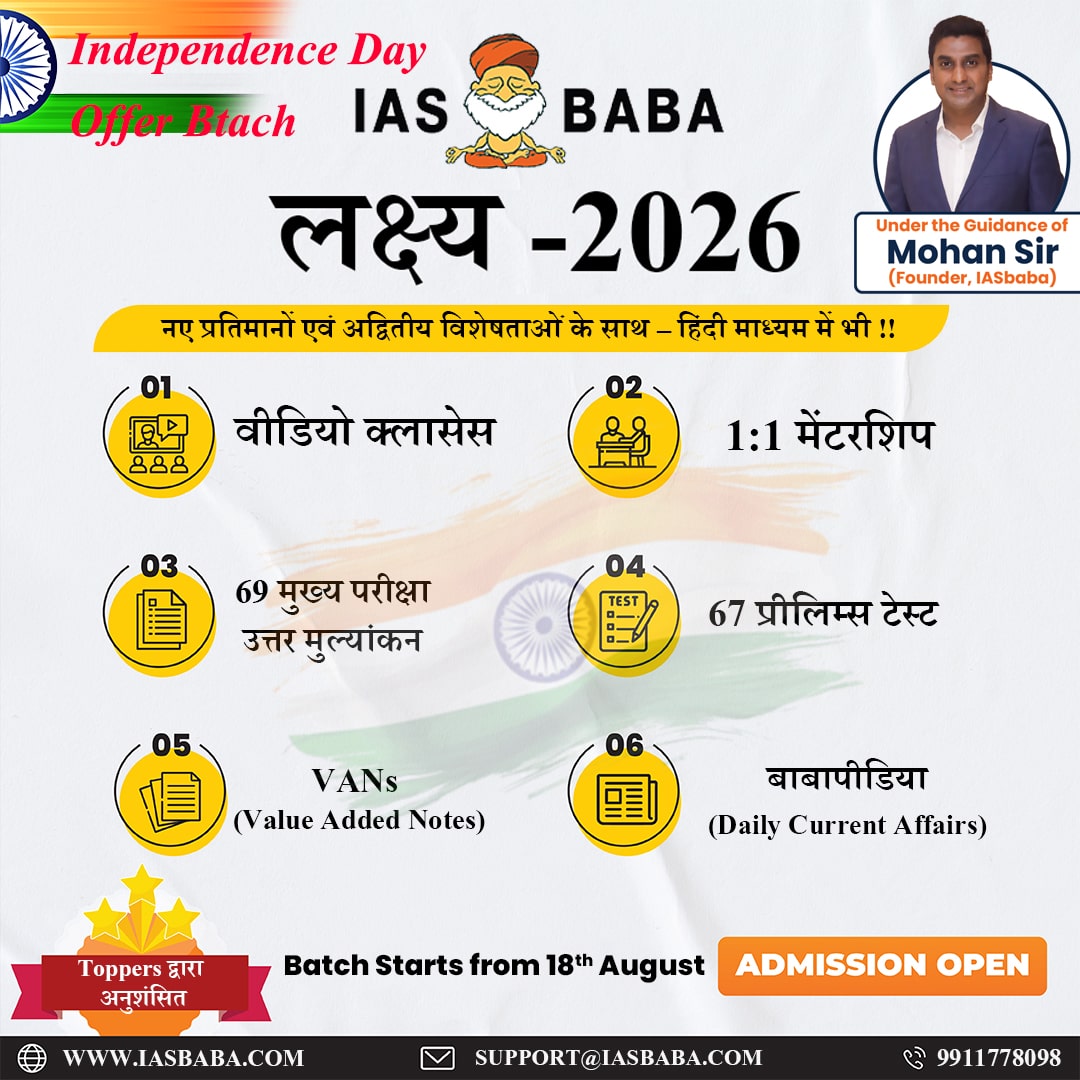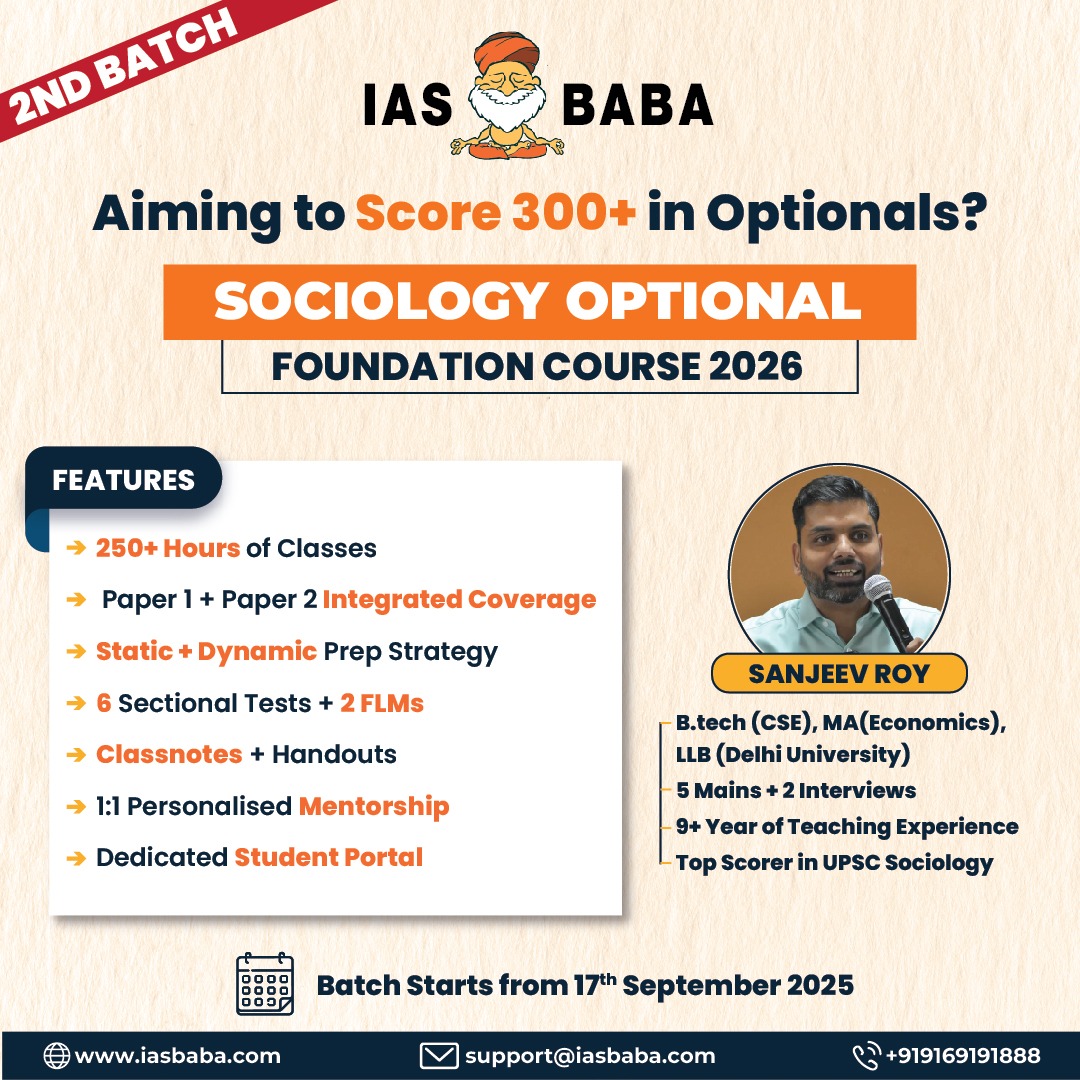IASbaba's Daily Current Affairs Analysis
Archives
(PRELIMS Focus)
Category: Polity and Governance
Context:
- The Supreme Court has provided its opinion on a Presidential reference made under Article 143.
About Advisory Jurisdiction of SC:
- Related Article: Article 143 (Advisory jurisdiction) empowers the President of India to seek the SC’s advisory opinion on any question of law or fact that is of public importance and is likely to arise or has already arisen.
- Exclusivity: The SC’s advisory jurisdiction is exclusive to the President.
- Significance: It gives the President the power to refer any question of law or fact of public importance to the Supreme Court for its opinion, based on the Union Council of Ministers’ advice.
- Opinion not binding: The opinion expressed by the SC is only advisory and not a judicial pronouncement. Hence, it is not binding on the president; she may follow or may not follow the opinion.
- Acts as authoritative legal opinion: Though advisory in nature, it facilitates the government to have an authoritative legal opinion on a matter to be decided by it.
- Minimum bench of 5 judges: Article 145 (3) requires such references to be heard by a bench of at least five judges.
- Historical Context:
- Advisory jurisdiction under Article 143 is derived from the Government of India Act, 1935, which allowed the Governor-General to refer legal questions to the federal court.
- The Canadian Constitution allows its SC to provide legal opinions, while the US SC refrains from giving advisory opinions to uphold a strict separation of powers.
- Past Instances of Such References: Some landmark cases include:
- Delhi Laws Act case (1951): Defined the scope of delegated legislation.
- Kerala Education Bill (1958): Harmonized Fundamental Rights with Directive Principles.
- Berubari case (1960): Held that territorial cession requires a constitutional amendment.
- Keshav Singh case (1965): Explained legislative privileges.
- Presidential poll case (1974): Allowed elections despite vacancies in State Assemblies.
- Third Judges case (1998): Established the Collegium system for judicial appointments.
Source:
Category: Science and Technology
Context:
- A Japanese delegation recently held discussions with the senior leadership of the ISRO and visited the facilities of the space agency to review the status of the LuPEX mission.
About LuPEX Mission:
- Collaborating agencies: It is a collaborative mission between Indian Space Research Organisation (ISRO) and Japan Aerospace Exploration Agency (JAXA).
- Objective: It aims to explore the moon’s southern polar region, investigating the presence of water and other elements, potentially in the form of surface ice.
- Scheduled launch: The mission is scheduled to launch in 2025.
- Uniqueness: The LUPEX will be a precursor to the ISRO’s lunar sample return mission and for sending the first Indian to the moon by 2040.
- Launch vehicles: The mission will be launched by JAXA onboard its H3-24L launch vehicle, carrying the ISRO-made lunar lander, which will carry the MHI, Japan-made lunar rover.
- Focus on lunar night survival: It aims to showcase innovative surface exploration technologies. The special focus is on vehicular transport and lunar night survival.
- Functions of rover: The rover will drive on its own to search for areas where water is likely to be present and sample the soil by digging into the ground with a drill. It will be equipped with instruments for measuring the water content of regolith (lunar sand), drilling, and sampling.
- Instruments of other space agencies carried: The rover will carry not only the instruments of ISRO and JAXA but also those of the US space agency NASA and the European Space Agency (ESA).
Source:
Category: Environment and Ecology
Context:
- Tata Power Company Ltd said it has signed commercial agreements with Druk Green Power Corporation Ltd (DGPC) for the development of Dorjilung hydroelectric power project in Bhutan.
About Dorjilung Hydroelectric Power Project:
- Location: It is a planned 1125 MW run-of-river project situated in the eastern Lhuentse and Mongar Districts of Bhutan.
- Associated river: It will be built on the Kurichhu River, a tributary of the Drangmechhu that flows into India.
- Partnership: Bhutan’s Druk Green Power Corporation (DGPC) has signed an MoU with Tata Power Company Limited for the joint development of the project.
- Use of SPV: The Project will be implemented through a Special Purpose Vehicle (SPV), with DGPC and Tata Power holding equity shares of 60% and 40%, respectively.
- Completion of the project: The project is expected to be commissioned by early 2032.
- Role of world bank: The project is financed by the World Bank.
- Power capacity: At a height of approximately 139.5 m, the concrete-gravity dam channels nearly 287 m3/s through a 15 km headrace tunnel to an underground powerhouse housing six Francis turbines, designed to generate around 4.5 terawatt-hours (TWh) annually.
- Estimated cost: At a total project cost of ₹13,100 crore, Dorjilung will be Bhutan’s second-largest hydropower project, and the largest Public–Private Partnership (PPP) hydro project ever undertaken in the country.
Source:
Category: History and Culture
Context:
- Marking World Heritage Week, the Archaeological Survey of India (ASI) organised a heritage walk and clean-up drive at the Brihadeeswarar Temple in Thanjavur.
About Brihadeeswarar Temple:
- Location: It is a Hindu temple dedicated to Shiva located in Thanjavur, Tamil Nadu.
- Other names: It is also known as Periya Kovil, RajaRajeswara Temple and Rajarajesvaram.
- Dravidian temple: It is one of the largest temples in India and is an example of Dravidian architecture during the Chola period.
- Construction: It was built by emperor Raja Raja Chola I and completed in 1010 AD.
- Uniqueness: It is part of the UNESCO World Heritage Site known as the “Great Living Chola Temples”, with the other two being the Brihadeeswarar Temple, Gangaikonda Cholapuram and Airavatesvara temple.
- Cultural Significance: It has a repository of Tamil inscriptions detailing rituals, gifts, and the temple’s construction overseen by Raja Raja Chola himself.
- Use of granite: The entire temple structure is made out of granite.
- Structure: The vimanam (temple tower) is 216 ft (66 m) high and is the tallest in the world. The Kumbam (the apex or the bulbous structure on the top) of the temple is carved out of a single rock and weighs around 80 tons.
- Area: The temple complex spans over 40 acres and is decorated with masses of sculptures and inscriptions that spotlight the era’s devotion and craftsmanship.
- Nandi statue at entrance: There is a big statue of Nandi (sacred bull), carved out of a single rock measuring about 16 ft (4.9 m) long and 13 ft (4.0 m) high at the entrance.
Source:
Category: Environment and Ecology
Context:
- Recently, RTI responses revealed that State Forest Departments across India have no record of African grey parrot trade.
About African Grey Parrot:
- Nature: It is a medium-sized, dusty-looking grey bird.
- Scientific Name: Its scientific name is Psittacus Erithacus.
- Uniqueness: It is one of the most talented talking/mimicking birds on the planet.
- Distribution: African grey parrots are native to West and Central Africa. They are kept as pets in many parts of the world, and their popularity dates back centuries.
- Habitat: They inhabit different types of lowland forest, including rainforest, woodlands, and wooded savannah. They can be seen along forest edges and in clearings as well, and sometimes feeding in gardens and cultivated fields.
- Lifespan: Usually, they live for more than 50 years.
- Features: It is a mottled grey-coloured, medium-sized parrot. It has a large black bill and white mask enclosing a yellow eye and has a striking red vent and tail.
- Difference between males and females: Females have a pale grey crown with dark gray edges, a grey body, and scarlet tail feathers. The male looks similar to the female but becomes darker with age.
- Conservation Status:
- It is classified as ‘Endangered‘ under the IUCN Red List.
- It is is listed under Appendix I of the Convention on International Trade in Endangered Species of Wild Flora and Fauna (CITES).
Source:
(MAINS Focus)
(UPSC GS Paper III – “Agriculture, Biotechnology and Food Security”)
Context (Introduction)
India’s projected 1.7 billion population by 2060, coupled with shrinking agricultural land, water stress, and climate volatility, makes genome editing and modern biotechnology essential tools to secure long-term food supply, nutrition, and farmer resilience.
Main Arguments: Why India Needs Genetic Engineering?
- Productivity Plateau: India’s crop yields have stagnated, and genome-edited varieties can reverse this trend at a time when the country spends $20 billion annually on edible oil imports.
- Climate Resilience: CRISPR-edited drought-, heat-, and salinity-tolerant lines like the improved Samba Mahsuri offer crucial protection amid rising climate shocks.
- Nutrition Security: Genome editing can enhance micronutrient density in staples, essential when one-third of Indian children remain stunted due to persistent malnutrition.
- Indigenous Technology: ICAR’s new TnpB-based editing tool strengthens India’s seed sovereignty by reducing dependence on CRISPR technologies controlled by foreign institutions.
- Resource Efficiency: GE crops improve water- and nutrient-use efficiency—critical as India is expected to enter severe water scarcity (<1,000 m³ per capita) by 2050.
Challenges Hindering Adoption
- Regulatory Uncertainty: Overlapping GM–GE rules and prolonged approval timelines discourage researchers and delay deployment of safe, non-transgenic innovations.
- Activist Opposition: Ideological resistance masquerading as environmentalism fuels distrust and blocked earlier breakthroughs like GM mustard.
- Perceived Monopolies: Concerns over corporate control persist even when the technologies (like TnpB) are public-sector and indigenously developed.
- Information Deficit: Low public awareness and circulating misinformation create political hesitancy and slow acceptance of GE crops.
- Scientific Demoralisation: Two decades since Bt Bollgard-II (2006) without new approvals have weakened morale among agricultural scientists and stalled innovation pipelines.
Way Forward
- Regulatory Clarity: India needs a differentiated, science-based framework—similar to Japan and Argentina—that fast-tracks approvals for non-transgenic genome-edited crops.
- Public-Sector Leadership: Greater ICAR funding and open-licensing models can ensure that genome-edited seeds remain affordable for small and marginal farmers.
- Field Validation: Large-scale demonstrations through Krishi Vigyan Kendras must highlight real-world improvements in yields, stress tolerance, and reduced chemical use.
- Scientific Literacy: A national GE awareness mission should counter misinformation through transparent communication involving universities, panchayats, and extension workers.
- Innovation Ecosystem: An integrated agri-biotech corridor connecting start-ups, ICAR labs, incubators, and seed companies can accelerate safe, equitable dissemination.
Conclusion
India’s future food and nutrition security will depend on its readiness to embrace safe, indigenous, precision breeding technologies. Rejecting genome editing due to misplaced fears risks deepening rural distress, increasing import dependence, and weakening the scientific foundations of Indian agriculture.
Mains Question
- Genetic engineering offers transformative potential for India’s agriculture, yet its progress has been hindered by regulatory hesitation and societal scepticism. Analyse the need, challenges, and way forward for GE technologies in the Indian context.(250 words, 15 marks)
Source: Indian Express
(UPSC GS Paper II – “Federalism, Centre–State Relations, Role of Constitutional Authorities”)
Context (Introduction)
The Supreme Court’s recent advisory opinion on Article 200, addressing the Governor’s discretion over State Bills and the absence of time limits, has revived debates on federal balance, constitutional morality, and the long-standing friction between Union-appointed Governors and elected State governments.
Main Arguments:
- Federal Tension: Expanding discretionary authority under Article 200 deepens structural frictions between Union-appointed Governors and opposition-ruled States, weakening cooperative federalism.
- Legislative Bottleneck: Indefinite delays in assent—such as past instances where Bills remained pending before the President for up to seven years—undermine legislative functioning and democratic accountability.
- Constituent Intent: Constituent Assembly debates and B.N. Rau’s notes indicate that discretionary powers in assenting to Bills were consciously removed, highlighting the need to uphold original constitutional design.
- Anti-Defection Impact: The Court’s assumption about assured majority support post-Tenth Schedule oversimplifies scenarios involving coalition shifts, making implicit discretion an unreliable safeguard.
- Governance Stability: Frequent disputes over assent impair day-to-day governance, as seen in multiple States approaching courts to compel Governors to act, reflecting a serious administrative and constitutional vacuum.
Challenges / Criticisms
- Expanded Discretion: The Court’s view effectively widens the Governor’s non-justiciable discretion, risking a shift from constitutional figurehead to active political arbiter.
- Weak Appointment Process: Ignoring recommendations of the Sarkaria, Venkatachaliah, and Punchhi Commissions has enabled politically motivated appointments, heightening partisan conflict.
- Political Friction: As Soli Sorabjee noted, using governorship as a role for “burnt-out politicians” exacerbates tensions when different parties control the Union and States.
- Judicial Vacuum: By refusing to prescribe timelines, the advisory opinion limits judicial remedies against prolonged inaction, perpetuating constitutional uncertainty.
- Risk of Gubernatorial Governance: If assent, withholding, and returning Bills become fully discretionary and non-reviewable, the Governor may effectively override the democratically elected State government.
Way Forward:
- Codified Timelines: Amending Article 200 to introduce strict timelines, as recommended by past commissions, would ensure timely legislative processing.
- Depoliticised Appointments: Adopting a consultative appointment mechanism—such as involvement of the Chief Minister or an inter-State council—can reduce partisan bias.
- Narrow Interpretation: Limiting discretion strictly to cases involving constitutional violations, in line with the Sarkaria Commission’s narrow construction, would restore federal balance.
- Judicial Oversight: Allowing courts to review prolonged or unexplained delays can prevent constitutional paralysis without undermining executive authority.
- Cooperative Protocols: Establishing Union–State coordination mechanisms for resolving disputes over assent can reduce litigation and strengthen democratic functioning.
Conclusion
Unchecked and non-justiciable gubernatorial discretion risks destabilising India’s carefully balanced federal architecture. Reforms—both procedural and constitutional—are essential to ensure that the Governor performs a neutral constitutional role while safeguarding democratic processes and legislative autonomy.
Mains Question
- The Supreme Court’s advisory opinion on Article 200 has widened the scope of gubernatorial discretion, raising concerns about federal balance and legislative autonomy. Critically analyse the constitutional, political, and administrative implications of this development.(250 words, 15 marks)
Source: The Hindu













